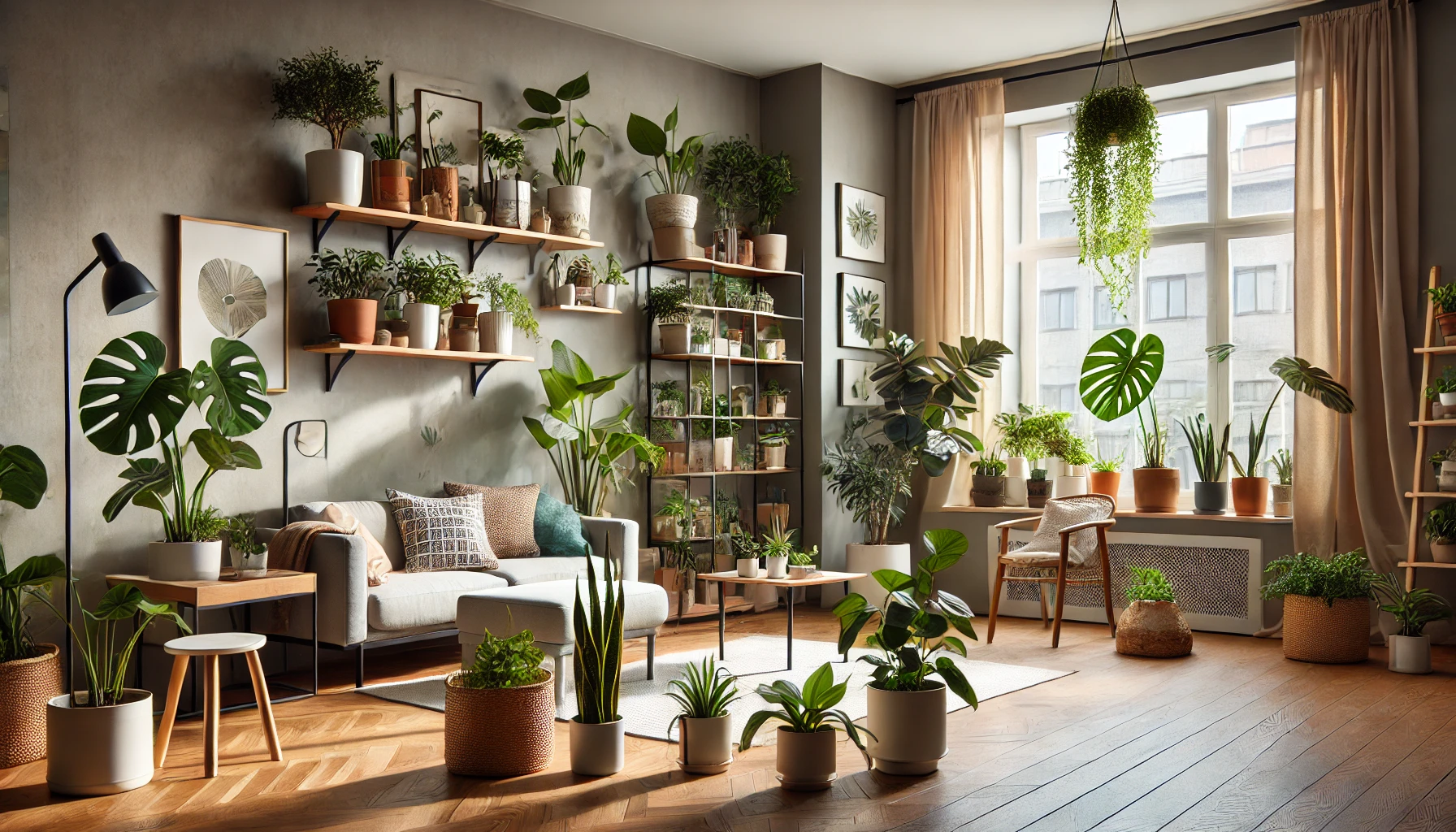Living in an apartment doesn’t mean you have to give up the joy of having indoor plants. In fact, plants can help bring life and color to even the smallest of spaces. Whether you’re a seasoned plant parent or new to the world of indoor gardening, it’s important to understand how to care for plants in an apartment environment. Apartments often have unique challenges, like limited natural light and small spaces, but with the right care, your plants can thrive.
In this article, we’ll explore some essential tips and tricks to help you keep your apartment plants healthy and happy.
1. Assess the Light in Your Apartment
Light is one of the most important factors to consider when choosing plants for your apartment. Many apartments have limited natural light, so it’s essential to know what kind of light each room gets throughout the day. Here’s how to assess your apartment’s lighting conditions:
- Bright, Indirect Light: If your apartment has windows with a lot of natural light but the sunlight is filtered through curtains or blinds, you have bright, indirect light. Many indoor plants, such as peace lilies, pothos, and spider plants, thrive in this type of light.
- Low Light: If your apartment is more shaded or lacks direct sunlight, you’ll need plants that can tolerate low light. Snake plants, ZZ plants, and ferns are perfect for darker rooms and corners.
- Direct Sunlight: If you have windows that get direct sunlight for several hours a day, you can grow sun-loving plants like succulents, cacti, or geraniums. Place these plants near south-facing windows for optimal sunlight exposure.
2. Choosing the Right Plants for Small Spaces
Space is often limited in apartments, so it’s important to select plants that fit well in your available space. Here are some tips for choosing plants based on the size of your apartment:
- Compact Plants: For smaller spaces, choose plants that don’t take up too much room. Small plants like succulents, pothos, and snake plants are perfect for shelves, tabletops, or windowsills.
- Hanging Plants: If you’re limited on floor space, consider hanging plants like English ivy, spider plants, or string of pearls. Hanging baskets or macrame plant hangers allow you to display greenery without taking up valuable surface area.
- Tall Plants: If you have a larger apartment or higher ceilings, you can opt for taller plants like the fiddle-leaf fig or monstera. These plants add height and a dramatic focal point to a room.
3. Watering Considerations for Apartment Plants
Watering is an essential part of plant care, and apartment plants can be particularly sensitive to overwatering or underwatering. The key is to understand your plant’s water needs and avoid watering too often. Here are some tips:
- Avoid Overwatering: Many apartment plants suffer from overwatering, especially if they’re in pots without drainage holes. Make sure to let the soil dry out between waterings. Always check the soil moisture before adding more water.
- Proper Drainage: Use pots with drainage holes to prevent water from accumulating at the bottom of the pot. Excess water can cause root rot and damage the plant’s roots. If your pot doesn’t have drainage, consider using a smaller container inside the decorative pot, or use less water.
- Check the Humidity: Apartments can be dry, especially during winter when the heating system is running. If you have tropical plants like peace lilies or ferns, you may need to increase the humidity around them. You can do this by misting the leaves, placing plants on a tray with water and pebbles, or using a humidifier.
4. Temperature and Air Circulation
Temperature and air circulation are crucial for the health of your apartment plants. Plants can be sensitive to extreme temperature changes or drafts. Here’s how to create the perfect environment for your plants:
- Keep Away from Drafts: Avoid placing plants near windows or doors that are frequently opened, as this can expose them to cold drafts. Also, keep plants away from heat sources like radiators, space heaters, and air conditioning units, which can dry them out.
- Maintain Ideal Temperatures: Most houseplants do well in temperatures between 60-75°F (15-24°C). Be mindful of any extreme temperature fluctuations, and try to keep the temperature consistent.
- Air Circulation: Good air circulation is important for preventing fungal growth and encouraging healthy plant growth. Don’t overcrowd your plants in one area. Ensure that the air can flow freely around each plant to prevent mold and mildew.
5. Fertilizing Apartment Plants
Fertilizing is essential for keeping your plants healthy, but apartment plants often don’t require as much fertilizer as outdoor plants. Use the following guidelines to fertilize your indoor plants effectively:
- Use the Right Fertilizer: Choose a balanced, water-soluble fertilizer that’s appropriate for your type of plant. Fertilizers formulated for houseplants are typically safe and provide the necessary nutrients for growth.
- Fertilize During Growing Season: The best time to fertilize your plants is during their growing season, typically in the spring and summer. You don’t need to fertilize as frequently in the fall and winter, as many plants go into dormancy.
- Don’t Over-Fertilize: Over-fertilizing can damage the plant. Stick to the manufacturer’s recommendations on the fertilizer package, and avoid fertilizing plants that are already healthy.
6. Indoor Plant Care for Small Spaces
When caring for apartment plants, especially in small spaces, it’s important to avoid overcrowding. Here’s how to maintain a healthy plant environment in your apartment:
- Don’t Overcrowd Your Plants: While it’s tempting to fill your apartment with plants, it’s important to leave enough space for each one to grow. Overcrowding can lead to poor air circulation and competition for light, making it harder for your plants to thrive.
- Rotate Plants for Even Growth: To ensure that each plant gets even exposure to light, rotate your plants regularly. This is especially important for plants placed near windows that may only get light from one side.
- Prune Dead or Yellow Leaves: Regularly trim any dead or yellowing leaves to help your plants conserve energy and focus on healthy growth. This also keeps your plants looking neat and encourages new growth.
7. Dealing with Common Apartment Plant Pests
Indoor plants can occasionally attract pests like spider mites, aphids, or mealybugs. These pests can cause damage to the leaves and overall health of the plant. Here’s how to handle common pests:
- Inspect Regularly: Keep an eye on your plants for signs of pests, such as discolored leaves, tiny webs, or sticky residue. The earlier you spot an infestation, the easier it is to treat.
- Use Natural Remedies: If you find pests, try natural remedies like neem oil, insecticidal soap, or a mixture of water and dish soap. Always test the solution on a small part of the plant first to ensure it doesn’t cause damage.
- Remove Damaged Leaves: If pests have damaged leaves, remove them to prevent the infestation from spreading. Dispose of the leaves outside, away from your other plants.
Conclusion: Creating a Green Oasis in Your Apartment
Caring for apartment plants is a rewarding and fulfilling hobby, and with the right care, your plants can thrive in even the smallest spaces. By understanding your plant’s needs in terms of light, temperature, humidity, and watering, you can create the perfect indoor environment for your plants. Whether you’re living in a tiny studio or a spacious loft, plants can help you create a vibrant and peaceful space.
With these tips, you can keep your apartment plants healthy and happy all year long, turning your apartment into a lush, green oasis.

